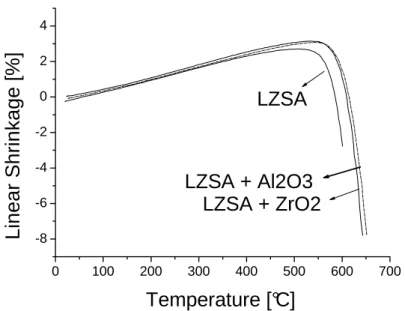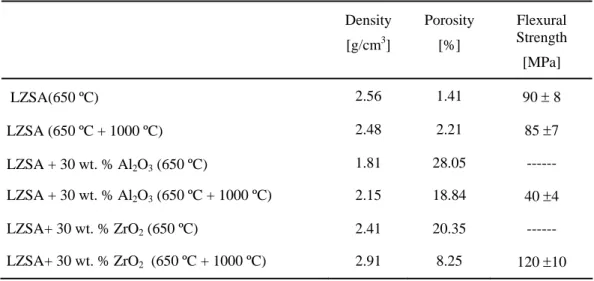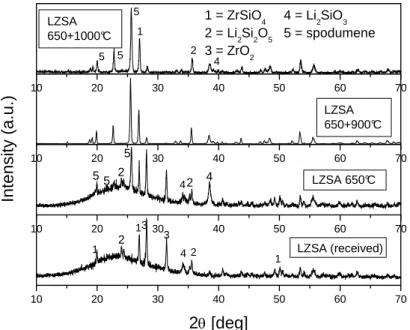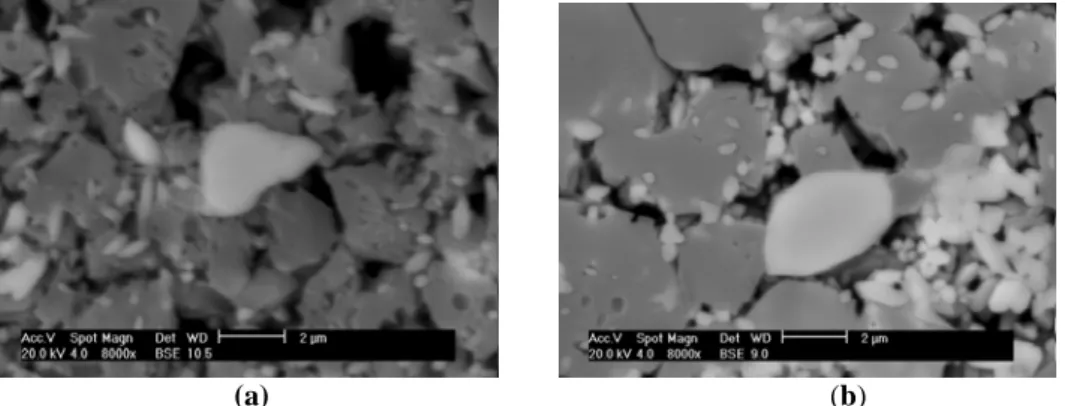ISSN 1 5 1 7 - 7 0 7 6
Revista Matéria, v. 14, n. 1, pp. 674 – 679, 2009 http://www.materia.coppe.ufrj.br/sarra/artigos/artigo11034
Autor responsável: Acchar, W. Data de envio: 28/02/2008 Data de aceite: 02/08/2008
Using ZrO
2or Al
2O
3particles to enhance the mechanical properties of a
LZSA glass-ceramic matrix
Acchar, W.I, II; Torquato, W.L.II; Sousa, C.R.C.III I
Department of Physics - Federal University of Rio Grande do Norte - UFRN - 59072-970, Natal, RN, Brazil e-mail: acchar@dfte.ufrn.br
II
Post-Graduation Program in Mechanical Engineering – Federal University of Rio Grande do Norte – UFRN – 59072-970, Natal-RN, Brazil
e-mail: wagnertorquato@gmail.com
III
Graduate Program in Material Engineering – Federal University of Rio Grande do Norte - UFRN - 59072-970, Natal, RN, Brazil UFRN, Natal-RN,Brazil
e-mail: clawsiocruz@gmail.com
ABSTRACT
Investigations of a range of glass ceramic compositions have been developed in the last decades. These materials show a good potential to be used at room temperature as a substitute to other ceramic materials, due to their lower sintering temperature and costs. The mainly reason that limits the use of these materials is their low mechanical strength. In this work a Li2O-ZrO2-SiO2-Al2O3 (LZSA) glass powder was mixed with 30 wt. % of ZrO2 or Al2O3 (submicron size), uniaxially pressed under 40 MPa and sintered at 650 °C/30 min. In some samples a second sintering step at 1000 °C during 30 minutes was also performed, in order to improve the mechanical properties by increasing the crystallized fraction. The sintered samples were characterized by bending strength measurements, X-ray diffraction and scanning electron microscopy analyses. Apparent densities values were determined by the Archimedes’s method. The results obtained in this work indicate that the addition of ZrO2 and Al2O3 (reinforcing particles) decreases the density of the glass-ceramic materials. X-ray diffraction analysis indicated an increase of the crystallized fraction in samples sintered at 1000 °C. Fracture strength values has showed to be dependent on the sintering temperature and also on the reinforcing crystalline particles.
Keywords: composite materials, mechanical properties, sintering, powder technology.
1 INTRODUCTION
temperatures and to investigate the potential use of aluminum or zirconium oxides as reinforcing elements in a LZSA matrix.
2 EXPERIMENTAL PROCEDURE
A glass ceramic powder consisted of Li2O-ZrO2-Al2O3-SiO2 (LZSA) with an average grain size of 4.0 μm was selected as the matrix raw material. This material was prepared from a mixture of commercially available raw materials, melted at approximately 1500 °C and quenched in water, in order to obtain a glass powder. Details about the preparation of the LZSA powders can be founded elsewhere [2]. Powders of alumina-α (Basserman) and ZrO2 (Aldrich) with an average grain size of 1.64 μm and 2.76μm, respectively were used as reinforcing elements. Mixtures containing a fixed concentration of 30 wt. % of Al2O3 or ZrO2 were prepared in a planetary ball milling. Subsequently, powders compacts were uniaxially pressed into prismatic bars (5 x 5 x 30 mm3) under 40 MPa. Specimens were sintered in air at 600 and 650 °C. Some samples were also submitted to a thermal treatment at 1000 °C, in order to improve the crystallization process. Glass ceramic powder without reinforcement was also prepared to be used as a reference material. The apparent density and porosity of the sintered specimens were measured using Archimedes water displacement method. The identification of crystalline phases was carried out by X-ray diffraction (XRD) on a diffractometer (Schimadzu XRD-600) operated at 40 kV with monochromatized CuKα radiation over a range 2θ from 20 to 80 °, at a scanning speed of 0.5°/min. A dilatometric study (BP Engineering RB-300) was carried out in air from ambient temperature up to 650 °C with a heating rate of 10°/min. The mechanical strength of the sintered samples was determined as the average of five measurements for each composition, using a universal testing machine (Zwick, 2.5 kN) in a four-point bending geometry, with upper and bottom knives span of 40 and 20 mm, respectively, at a constant cross-head speed of 0.5 mm/min, according to EN 100 method.
3 RESULTS AND DISCUSSION
Figure 1 depicts the dilatometric curve obtained for pure LZSA. According to this Figure, the sintering process starts at around 560 ºC. The effect of the reinforcing elements on the dilatometric behavior of LZSA is showed also in Figure 1. The Al2O3 or ZrO2 incorporation causes a change on the onset of the sintering temperature. This is a clear evidence that the presence of both reinforcing elements delay the shrinkage process and, as a consequence, also the beginning of the sintering process of the reinforced LZSA glass material. The pure LZSA glass material was chosen to illustrate the typical thermal behavior of the investigated glass materials, which is shown in Figure 2. According to the DTA curve an endothermic inflection at around 600 ºC can be seen, corresponding to the glass transition. The exothermic peaks that occur between 700 and 850 ºC are characteristic of the glass crystallization, which is in agreement with the results of the X-ray diffraction analyses, showed in Figure 3, and with the results reported in the literature [1,
2].
0 100 200 300 400 500 600 700
-8 -6 -4 -2 0 2 4
LZSA + ZrO2
LZSA + Al2O3
LZSA
Linear Shrinkage [
%
]
Temperature [°C]
Figure 1: Influence of Al2O3 and ZrO2 on the dilatometric behavior of LZSA glass.
0 200 400 600 800 0
-2 -4 -6 -8 -10 -12 -14
DTA - LZSA
DT
A [
μ
V]
Temperature (°C)
Figure 2: Differential thermal analysis (DTA) of LZSA glass material.
Table 1 summarizes the evaluated parameters of LZSA with Al2O3 or ZrO2. It can be noted that the increase of the sintering temperature from 600 to 1000 °C reduces the densification of pure LZSA glass material, which is probably related to the volatility of the LZSA glass at high temperatures. The increase of the porosity values observed in the LZSA glass material with additions of Al2O3 and ZrO2 at 650 °C can be attributed to the difficulty to sinter the LZSA glass material with the incorporation of alumina particles. The presence of rigid particles of Al2O3 or ZrO2 in the LZSA glass material probably reduces the mobility of the LZSA grain boundaries during the sintering process and prevents full densification. Similar behavior was also founded for other composite systems such as Al2O3 + carbides [6, 9, 11] and ZrO2+WC [13]. Contrary to that, the reinforcing materials show an improvement of the densification by increasing the temperature. The ZrO2 reinforcing material presents a decrease of the porosity values from 20.35 to 8.25 %, showing a good potential to be used as reinforced element in the LZSA glass matrix. The increase of the sintering temperature to 1000 °C has reduced the porosity of the Al2O3-LZSA composite material, but not to the adequate porosity level as observed for the ZrO2-LZSA material.
Table 1: Porosity, density and strength values obtained in this work
Density [g/cm3]
Porosity [%]
Flexural Strength [MPa]
LZSA(650 ºC) 2.56 1.41 90 ± 8
LZSA (650 ºC + 1000 ºC) 2.48 2.21 85 ±7
LZSA + 30 wt. % Al2O3 (650 ºC) 1.81 28.05 ---
LZSA + 30 wt. % Al2O3 (650 ºC + 1000 ºC) 2.15 18.84 40 ±4
LZSA+ 30 wt. % ZrO2 (650 ºC) 2.41 20.35 ---
LZSA+ 30 wt. % ZrO2 (650 ºC + 1000 ºC) 2.91 8.25 120 ±10
characteristic amorphous behavior, presenting mainly the presence of ZrSiO4 and ZrO2 peaks. The X-ray pattern of the material sintered at 650 ºC showed a reduction of the amorphous behavior and a crystallization process with the presence of β-spodumene. The increase of the temperature to 1000 ºC has induced the disappearance of the amorphous characteristic, with the material showing only well defined crystalline peaks. Figure 4 shows the X-ray pattern of the reinforced material sintered at 650 °C and submitted to a crystallization treatment at 1000 °C. The X-ray analyzes didn’t show the presence of an amorphous characteristic. The sintered composite materials show well defined crystalline peaks. The incorporation of Al2O3 and ZrO2 to the material has caused the presence of Al2O3 and ZrSiO4 and ZrO2.
10 20 30 40 50 60 70
1
1 2 4
Inte
nsity (a.u.
)
2θ [deg]
10 20 1 30 40 50 60 70
4 2 2
5 5
5 LZSA 650°C
10 20 30 40 50 60 70
3 3
LZSA 650+900°C
10 20 30 40 50 60 70
4 2 2 4 5 1 5
5 4 = Li
2SiO3
5 = spodumene 1 = ZrSiO4
2 = Li2Si2O5 3 = ZrO2
LZSA (received) LZSA
650+1000°C
Figure 3: X-ray diffraction of LZSA glass material.
10 20 30 40 50 60 70 80
4 2 2 1 5,2 5 5 5 Intens ity [a. u .] LZSA 650+1000 C
10 20 30 40 50 60 70 80
1
6 6 6
6
5
LZSA + 30% Al2O3 650-1000 C
10 20 30 40 50 60 70 80
3 5
4 = Li2SiO3 5 = spodumene 6 = Al2O3 1 = ZrSiO4
2 = Li2Si2O5 3 = ZrO2
2θ[deg]
2 3 3
3
3
LZSA + 30% ZrO2 650-1000 C
Figure 4: X-ray diffraction of LZSA glass material with Al2O3 and ZrO2 additions sintered at 650 ºC and submitted to a crystalline treatment at 1000 ºC.
Table 1 shows the flexural strength values determined in this work. The LZSA glass material shows a better behavior at lower sintering temperatures. It can be noted that the strength of LZSA is decreased with increasing temperature. This behavior can be related to the decrease of the densification of this material that is associated to the lithium evaporation that takes place at high temperatures, showing that the temperature of 1000 °C is too high to sinter the pure LZSA material. The presence of 30 wt. % Al2O3 caused a significant decrease on the strength of the LZSA glass material, which can be attributed to the increase on the porosity level of the composite material as compared to the LZSA glass material at the same conditions. The presence of ZrO2 shows a divergent behavior. The LZSA + 30 wt. % ZrO2 sintered at 650 ºC and submitted to a crystallization treatment at 1000 ºC causes an improvement of the mechanical property. Strength values ranged from 85 to 120 MPa. It was not possible to measure the strength of the composite materials (with ZrO2 or Al2O3) sintered at 650 °C, because they were very fragile. The mechanical property observed in this work has showed to be a simultaneous function of the four effects: the sintering temperature, the porosity level, the second phases and the presence of crystallized phases. By increasing the temperature some parameters are improved and others become worse.
Figure 5a and 5b show a typical microstructure of the pure LZSA material and LZSA + 30 wt. % ZrO2, sintered at 650 ºC and submitted to a crystallization treatment at 1000 ºC. The LZSA glass material shows a β-spodumene grain size of approximately 2 μm and ZrSiO2 (white particles). The LZSA+ZrO2 material shows a similar microstructure, with various small particles around the grain boundary.
(a) (b)
Figure 5: Micrograph of pure LZSA (a) and LZSA + 30 wt. % ZrO2 (b) sintered at 650 °C and submitted to a crystallization treatment at 1000 °C.
4 CONCLUSIONS
The results obtained from the characterization of pressureless sintered LZSA with alumina or zirconium oxide revealed that:
1- The addition of ZrO2 and Al2O3 reduces the densification process of the LZSA glass material. 2- The flexural strength values have shown to be dependent on the presence and type of a second phase and on the sintering temperatures.
3-The presence of ZrO2 and Al2O3 shows a divergent behavior. The addition of ZrO2 improves the mechanical behavior of the LZSA glass material at 1000 ºC, but the incorporation of Al2O3 decreases the strength values.
3- The X-ray diffraction analysis shows the presence of ZrSiO2, ZrO2, Al2O3 and β-spodumene. 4- The material shows a dependence of the crystallization process on the sintering temperature. At 650 ºC the LZSA material still shows an amorphous characteristic. The increase of the temperature to 1000 ºC improves the crystallization process, showing the material no amorphous behavior.
5 ACKNOWLEDGEMENTS
The Authors of this work thank to the CNPq for the financial support and the Federal University of Santa Catarina for the LZSA powder.
6 REFERENCES
[1] OLIVEIRA, A.P., DURAN, R., CENTRITTO, N., BERNARDIN, A.M., Introducción a los Esmaltes
Ceramicos, 1 ed., Castellón, Spanien, Faenza Editrice Ibérica, 2002.
[2] OLIVEIRA, A.P., Progettazione, caratterizzazione ed ottenimento di vetri-vetroceramici appartenenti al
sistema LiO2-ZrO2-SiO2, PhD degree thesis in Materials Engineering, Universitá degli Studi di
Modena e Reggio Emilia, UNIMO, Itália, 1998.
[3] CHAIM, R., TALANKER, V., “Microstructure and mechanical properties of SiC platelet/cordierite glass-ceramic composites”, Journal of the American Ceramic Society, v. 78, n. 1, pp. 166-172, 1995. [4] ACCHAR, W., MARTINELLI, A.E., CAIRO, C.A.A., “Reinforcing Al2O3 with W-Ti mixed carbides”,
Materials Letter, v. 46, n. 4, pp. 209-211, 2000.
[5] ACCHAR, W., MARTINELLI, A.E., VIEIRA, F.A., CAIRO, C.A.A., “Sintering behavior of alumina-tungsten carbide”, Materials Science and Engineering A, v. 284, n. 1-2, pp. 84-87, 2000.
[6] ACCHAR, W., GREIL, P., MARTINELLI, A.E., CAIRO, C.A.A., BRESSIANI, A.H.A, BRESSIANI, J.C., “Sintering behavior of alumina-niobium carbide composites”, Journal of the European
Ceramic Society, v. 20, n. 11, pp. 1765-1769, 2000.
[7] PASOTTI, R.M.R., BRESSIANI, A.H.A., BRESSIANI, J.C., “Sintering of alumina-niobium carbide composites”, International Journal of Refractory Metals & Hard Materials, v. 16, n. 4-6, pp. 423-427, 1998.
[8] TAI, W.P., WATANABE, T., “Fabrication and mechanical properties of Al2O3-WC composites by vacuum hot-pressing”, Journal of the American Ceramic Society, v. 81, n. 6, pp.1673-76, 1998. [9] ACCHAR, W., CAIRO, C.A.A., SEGADAES, A.M., “Effect of tungsten carbide additions on the
microstructure and properties of hot-pressed alumina”, Materials Science & Engineering A, v. 406, n. 1-2, pp. 74-77, 2005.
[10] ACCHAR, W., FONSECA, J.L., “Sintering behavior of alumina reinforced with (Ti,W) carbides”,
Materials Science & Engineering A, v. 371, n. 1-2, pp.382-387, 2004.
[11] ACCHAR,W., SCHWARZE, D., GREIL, P., “Sintering of Al2O3-NbC composites using TiO2 and MnO additives”, Materials Science & Engineering A, v. 351,n. 1-2, pp. 299-303, 2003.
[12] CHOI, S.R., BANSAL, N.P., “Mechanical behavior of zirconia/alumina composites”, Ceramic
International, v. 31, n. 1, pp. 39-46, 2005.
[13] ANNÉ, G., PUT, S., VANMEENSEL, K., JIANG, D., VLEUGELS, J., VAN DER BIEST, O., “Hard, tough and strong ZrO2-WC composites from nanosized powders”, Journal of the European Ceramic
Society, v. 25, n. 1, pp.55-63, 2005.



